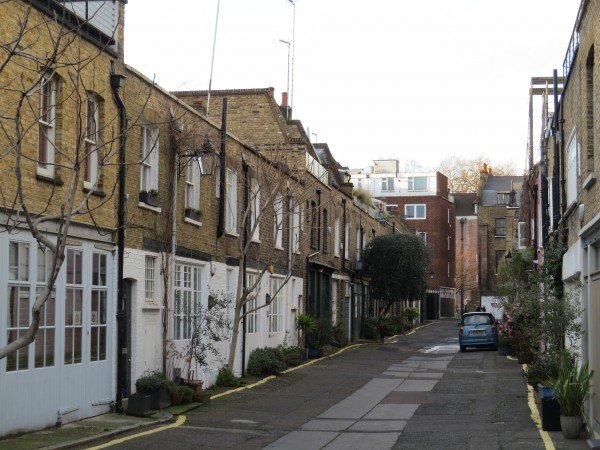Chancery Lane Station - Gray's Inn - John Street - Doughty Mews - Doughty Street - Mecklenburgh Square - St. George's Gardens - Hunter Street - Brunswick Square - Guilford Street - Russell Square Station (about 1 hour)
From Chancery Lane Underground Station you only have a brief walk west along High Holborn to get to Gray's Inn. This is one of the four most famous Inns of Court, and although it was more severely damaged by bombing in the war than the others, quite a few interesting buildings remain. The arched gatehouse on the north side of High Holborn is a reconstruction of an early timber building that was covered in stucco in the nineteenth century, rather an interesting street facade rebuilt in replica.

Go through the arch and proceed straight ahead past the first range into South Square. The Hall in front of you is the outstanding feature of the square. With its classic medieval plan, it dates back to the sixteenth century but has been substantially rebuilt. The adjacent chapel was originally also medieval, but has been rebuilt and restored a number of times from the sixteenth to the twentieth century. Note also the respectfully neo-Georgian but modern 10 South Square by Raymond Erith next to the Hall, and the post-war reconstruction work by Sir Edward Maufe around the square, particularly on the east side.
Now go north into Gray's Inn Square, where a number of early buildings from the late seventeenth century survive among post-war reconstructions. Further on, through the arch at the north east corner there are some Georgian chambers dating from the early nineteenth century, and from here you can admire the gardens, the pleasantly laid out 'Walks'.

You can retrace your steps southwards through them, if they are open (normally between 12 noon and 2.30 p.m.) or back down through Gray's Inn Square, and then into Field Court. On the south side is the fine Queen Anne facade of no.2, with its keystones and aprons round the windows, and on the north, no. 4 which presents a complete contrast in its grand but pleasing Edwardian Baroque.

Further on, passing a pretty stucco domestic-looking range with Regency balconies, walk northwards again up the west side of Gray's Inn, where as you walk past the terraces you can compare the modern reconstructed Georgian of Atkin Building with the genuine article of Raymond Buildings.
As you approach the northern perimeter, imagine it as it was at the time Gray's Inn was built, when it looked out on completely open countryside up towards Hampstead. Go out beside the gatehouse, crossing Theobald's Road, and turn right then immediately left into John Street, a good Georgian street dating from the mid-eighteenth century, its doorcases having the Greek features that by now had superseded the Baroque canopies of the Queen Anne period. If you are getting bored with Georgian, have a look at the unexpected Art Deco facade of No. 21. Doughty Street is to the north, later Georgian, with Dickens House at no.48, built at the beginning of the nineteenth century.

Next turn left into Doughty Mews where John Street meets Doughty Street. This is the nearest Bloomsbury gets to Chelsea, but it is perhaps even more pleasing for being not so well known and less sanitised. Here you will still get a strong flavour of a Georgian mews.

Emerging at the top end, cross Guilford Street, turning slightly to the right, and head north again joining Doughty Street for its upper section. You can contrast the striking difference between the simple classic Georgiana here and the much grander terraces of Mecklenburgh Square ahead. This is where S.P. Cockerell's plans resulted in Joseph Kay's stuccoed and pilastered frontages in the first decade of the nineteenth century, a sort of riposte to Adam's slightly earlier Fitzroy Square.
Continue north past more Georgian terraces in Mecklenburgh Street, then turn left at Heathcote Street. From here, right at the far end, you can walk through a gate into St. George's Gardens.

This is a pleasant oasis of a kind that somehow epitomises Bloomsbury. It was one of the first burial grounds to be established away from a church, for St. George's Bloomsbury and St. George the Martyr, Queen Square. You will pass some interesting chest tombs and other memorials including an obelisk, as you go west through the gardens, emerging at Handel Street, where the attractive Queen Anne Revival Hunter Street Health Centre stands on the corner with Hunter Street.
Heading south, Hunter Street is dominated on the right by the neo-Corbusian modernism of the Brunswick Centre. On your left, note a forlornly surviving handsome pair of Georgian townhouses next to the London University School of Pharmacy. This was begun in 1939 but not completed till after the second world war, another medical building, less attractive but equally characteristic of its time. Here you can cross into the simply laid out but pleasant Brunswick Square. Opposite, still the Brunswick Centre, though this is its best elevation with its echoes of continental Expressionism.
Continuing south down Grenville Street the other side of the square, you get a glimpse of Colonnade, the mews behind Guilford Street. Turning right into Guilford Street, you can admire James Burton's pilastered terraces which echo those of Adam and Kay in a less extravagant way.

Round the corner you pass the other end of Colonnade, and just round the corner again in Bernard Street is Russell Square Station, where your tour ends.
Anthony Jennings 2012